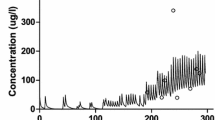Summary
The kinetics of morphine and its glucuronidated metabolites were investigated in seven patients with advanced renal failure. The terminal elimination half life of morphine varied between 1.5 and 4.0 h (mean 2.4 h), the volume of distribution between 2.5 and 6.3 l·kg−1 (mean 4.4 l·kg−1) and the total plasma clearance between 13.3 and 31.3 l·min−1·kg−1 (mean 21.1 l·kg−1). There were no statistically significant differences between the pharmacokinetic data in the uraemic patients and in a control group of cancer patients with normal kidney function. The concentrations of the glucuronidated metabolites rapidly rose to levels above those of morphine. The elimination half-life of M3G varied between 14.5 and 118.8 h (mean 49.6 h) in the renal failure patients, which is distinctly different from the 2.4 to 6.7 h (mean 4.0 h) found in patients with normal kidney function. There was a significant correlation between the half-life of M3G and renal function estimated as serum urea. Thus, the metabolism of morphine in patients with kidney disease is not significantly impaired. The clinical importance of the high concentrations of glucuronides in uraemic patients is not known.
Similar content being viewed by others
References
Bennet WM, Singer J, Coggins CJ (1980) Drug therapy in renal failure: Dosing guidelines for adults. Ann Intern Med 93: 286–325
Reidenberg HM (1977) The biotransformation of drugs in renal failure. Am J Med 62: 482–485
Boerner U, Abbott S, Roe R (1975) The metabolism of morphine and heroin in man. Drug Metab Rev 4: 39–73
McQuay H, Moore A (1984) Be aware of renal function when prescribing morphine. Lancet 2: 284–285
Ball M, Moore RA, Fisher A, McQuay H, Allen Mc, Sear J (1985) Renal failure and the use of morphine in intensive care. Lancet 1: 784–786
Aitkenhead AR, Vater M, Achola K, Cooper CMS, Smith G (1984) Pharmacokinetics of single-dose i. v. morphine in normal volunteers and patients with endstage renal failure. Br J Anaesth 56: 813–819
Hanks GW, Aherne GW (1985) Morphine metabolism. Does the renal hypothesis hold water? Lancet 1: 221
Säwe J, Svensson JO, Odar-Cederlöf J (1985) Kinetics of morphine in patients with renal failure. Lancet 2: 211
Svensson JO, Rane A, Säwe J, Sjöqvist F (1982) Determination of morphine, morphine-3-glucuronide, and (tentatively) morphine-6-glucuronide in plasma and urine using ion-pair high performance liquid chromatography. J Chromatogr 230: 427–432
Säwe J, Kager L, Svensson JO, Rane A (1985) Oral morphine in cancer patients in vivo kinetics and in vitro hepatic glucuronidation. Br J Clin Pharmacol 19: 495–501
Säwe J (1984) Oral morphine and methadone in the treatment of cancer pain. Clinical pharmacokinetic studies. Doctoral thesis in Medical Science at the Karolinska Institute, Stockholm, Sweden
Aherne GW (1983) The specificity of morphine radioimmunoassays. Roy Soc Med Int Congr Symp Ser 58: 21–26
Grabinski PY, Kaiko RF, Walsh TD, Foley KH, Houde RW (1983) Morphine radioimmunoassay specificity before and after extraction of plasma and cerebrospinal fluid. Pharmacol Sci 72: 27–30
Joel SP, Osborne RJ, Nixon NS, Slevin ML (1985) Morphine-6-glucuronide an important metabolite. Lancet 1: 1099–1100
Aherne GW, Littleton P (1985) Morphine-6-glucuronide, an important factor in interpreting morphine radio-immunoassays. Lancet 1: 210–211
Dutton GJ (1966) The biosynthesis of glucuronides. In: Dutton GJ (ed) Glucuronic acid. Academic Press, New York, pp 195–299
Dutton GJ (1978) Developmental aspects of drug conjugation, with special reference to glucuronidation. Ann Rev Pharmacol Toxicol 18: 17–35
Pacifici GM, Rane A (1982) Renal glucuronidation of morphine in the human foetus. Acta Pharmacol Toxicol 50: 155–160
Odar-Cederlöf I, Vessman I, Alván G, Sjöqvist F (1977) Oxazepam disposition in uremic patients. Acta Pharmacol Toxicol 40 [Suppl K]: 52–62
Don HF, Dieppa RA, Taylor P (1975) Narcotic analgesic in anuric patients. Anesthesiology 42: 745
Reynard CFB, Twycross RG (1984) Metabolism of narcotics. Br Med J 288: 860
Shirmomura K, Kamato O, Veki S (1971) Analgesic effects of morphine glucuronides. Tohoku J Exp Med 105: 45–52
Yosimura H, Ida S, Oguri F, Tsukamoto H (1973) Biochemical basis for analygesic activity of morphine-6-glucuronide. I. Penetration of morphine-6-glucuronide in the brain of rats. Biochem Pharmacol 22: 1423–1430
Author information
Authors and Affiliations
Rights and permissions
About this article
Cite this article
Säwe, J., Odar-Cederlöf, I. Kinetics of morphine in patients with renal failure. Eur J Clin Pharmacol 32, 377–382 (1987). https://doi.org/10.1007/BF00543973
Received:
Accepted:
Issue Date:
DOI: https://doi.org/10.1007/BF00543973




